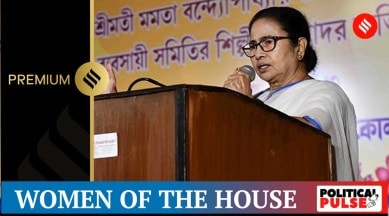Atri Mitra is a Special Correspondent of The Indian Express with more than 20 years of experience in reporting from West Bengal, Bihar and the North-East. He has been covering administration and political news for more than ten years and has a keen interest in political development in West Bengal. Atri holds a Master degree in Economics from Rabindrabharati University and Bachelor's degree from Calcutta University. He is also an alumnus of St. Xavier's, Kolkata and Ramakrishna Mission Asrama, Narendrapur. He started his career with leading vernacular daily the Anandabazar Patrika, and worked there for more than fifteen years. He worked as Bihar correspondent for more than three years for Anandabazar Patrika. He covered the 2009 Lok Sabha election and 2010 assembly elections. He also worked with News18-Bangla and covered the Bihar Lok Sabha election in 2019. ... Read More
Mamata to the fore, steady but slow rise in women candidates, winners
West Bengal ranked second in women representation, at 14% of Assembly strength; TMC takes pride in fielding 41% women among its 2019 LS candidates.

Top 6 states and a Bottom 1: Why the road to 33% quota for women is very long. You can read the first part of the series here.
AT 13.7% representation at the end of December 2022, when the data was compiled by the Centre for a reply in Parliament, West Bengal ranked second in the country among states in representation of women in its Assembly – preceded only by Chhattisgarh. The women MLAs in the state include Chief Minister Mamata Banerjee, now the only woman CM in the country.
monthly limit of free stories.
with an Express account.
One reason why the share of women in the Bengal Assembly has been around the 14% mark – the same as their proportion in Parliament, but still less than half the 33% quota envisaged by the Nari Shakti Vandan Adhiniyam – is believed to be the impact of Mamata as both the leader of the ruling party and the government in the state, and the Trinamool Congress encouraging women candidates.
In October 2021, after Congress general secretary Priyanka Gandhi Vadra announced that her party would allot 40% tickets to women for the 2022 Uttar Pradesh Assembly elections, the TMC said she was trying to “emulate” Mamata. In a post then, the TMC said it was “the first to give 40% seats to women in Lok Sabha elections”, referring to the party fielding 17 women for the total 42 Lok Sabha seats in the 2019 general elections in the state. In the 2014 Lok Sabha polls, 28% of the TMC’s candidates were women.
In terms of the Assembly, the picture is less rosy. The current House has 41 women among the total 294 MLAs, of whom Mamata was elected in a bypoll after the 2021 Assembly elections.
The Assembly elected after the 2016 elections had 39 women MLAs (13.26%). In the 2011 elections, when the TMC replaced the Left Front in power after three decades, 34 women MLAs were elected, or around 11.56% of the total.
Of the 41 women MLAs currently, 34 are from the TMC, and seven from the BJP.
The number of elected women MLAs in the state has also been rising at a faster rate than the increase in number of women candidates fielded by parties. For example, in the 2011 Assembly elections, 174 of the 1,972 candidates were women (or about 8%). In 2016, this rose to 200 of 1,961 candidates (or about 10%). By 2021, 240 of the 2,132 candidates were women (11.2% of the total).
Correspondingly, their share in the House rose from 11.56% in 2011 to 13.26% in 2016, and 14% in 2021.
In the 2006 Assembly elections, the last won by the Left Front, there were 139 women among the 1,654 contestants (8% of the total). Of them, 37 women won, putting their share at 12.5%.
The number of women elected to the Lok Sabha from West Bengal has been rising in even higher proportion than their numbers fielded.
In the 2014 Lok Sabha elections, there were 52 women among 471 in fray for the state’s 42 seats (11% of total). Of them 13 won, making their proportion 31% (close to the 33% mark). In the 2019 Lok Sabha polls, the proportion of women candidates fielded rose slightly, at 53 of total 466 (11.3%). Out of them, 11 won. This dropped their share to 26.19%, lower than 2014 but still high compared to the other states.
While welcoming the women’s reservation Act, Ujjaini Halim, coordinator of the West Bengal Election Watch-ADR, says: “Reservation is not a permanent solution to the problem of gender imbalance in political representation. There are fundamental issues like gender gap, social and economic disempowerment of women, which need to be addressed systematically to ensure gender equality and equity in all spheres of life… Even today, among major political parties, we see a negligible number of women leaders.”
Three-time TMC MLA Sheuli Saha says: “Our leader Mamata Banerjee has always stressed on increasing the number of female candidates. Some of them may be defeated, but she has never backtracked from her policy.”
BJP first-time MLA Agnimitra Paul says women representatives can influence debate in the House positively. “They can be more vocal in the Assembly or Parliament on women issues like rape, molestation and women empowerment.”
CPI(M) leader Sujan Chakraborty contests the claim that Mamata’s rise has spurred women’s representation in politics in Bengal. Linking it to quota in panchayati raj institutions for women, he says: “We, the Left, have been demanding (reservation for women in the Assemblies and Lok Sabha) for decades. And now we are saying that it should be implemented very soon and not after five or 10 years.”